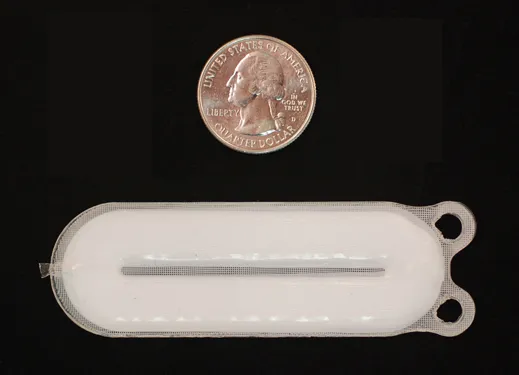14 years ago, during the most fierce moments of the "wars for the stem cells" that faced scientists and the White House of George W. Bush, there was a group of defenders of the research with which you could always count to campaign: Parents of children with type 1. diabetes motivated by researchers who told them that these cells would give rise to incredible priests, spent millions on television ads, pressure campaigns and innumerable calls to Congress.
Now has finally started the first trial of a type 1 diabetes treatment using stem cells.In October last year, two laboratory pancreatic cell bags derived from human embryonic stem cells in a man from San Diego (USA) were inserted through an incision in the back.Since then two other patients have received a substitute pancreas designed by a small company in San Diego called Viacyte.
It is also an important step because this Viacyte essay is only the third treatment based on stem cells that is tested in the United States.These cells, once extracted from human embryos in their early phases, can be grown in the laboratory and maintain their ability to become any type of cell or body tissue.Another essays, which has already been canceled, treated several patients with marrow injuries (see Geron closes a pioneering program of stem cell research), while tests to transplant retinal cells grown in the laboratory in the eyes of people whoThey are staying blind, see retinal transplants from stem cells).
Patients with type 1 diabetes have to constantly monitor their blood glucose level by punctures in the fingers, carefully measure when and what they eat, and routinely inject the insulin that their pancreas should manufacture.Insulin triggers the withdrawal of excess blood glucose to store it in fat and muscles.In the case of type 1 diabetics, the pancreas does not manufacture it because its own immune system has attacked and destroyed the pancreatic islets, the tiny groups of cells that contain the beta cells they secrete insulin.
Routine is especially hard for children, but if they do not manage their glucose they could properly suffer neuronal, kidney, blindness, and face a minor life expectancy.But despite years of research, there is still nothing "to offer patients, explains the doctor of the University of California in San Diego (USA), Robert Henry, whose center is doing surgeries for Viacyte.
Henry exaggerates a little, but not too much.There is something called Edmonton protocol, a surgical technique described for the first time in New England Journal of Medicine in 2000 that uses islets collected from corpses.When transplanting them, doctors from the University of Alberta (Canada) got the seven transplanted patients not to use insulin for a whole year.
However, hopes put in the Edmonton protocol were lost quickly.Only half of treated patients have still not use long -term insulin and the procedure, which forces patients to take powerful immunosuppressive medications throughout life and are still considered experimental in the United States, is not covered by medical insurers.In addition, there are very few appropriate pancreas donors.
The success of the Edmonton protocol came just two years after the discovery of embryonic stem cells in 1998. Those who were looking for a cure for diabetes quickly set a new goal: to combine something like Edmonton's protocol with beta cell technology cultivated in laboratory, whoseSupply provision is theoretically infinite.
"We already had the proof of concept that a transplant restores the beta function and independence of insulin," says the scientific director of the Research Foundation in Youth Diabetes (JDRF, for its acronym in English), Richard Insel.The JDRF is a non -profit organization that has 300,000 members."So it was evident that if we had another source of renewable cells, many people would benefit."
That is why the JDRF fought against the restrictions with which the White House of Bush threatened, and that is why its members supported a popular initiative in California (USA) that created the Institute of California of Regenerative Medicine, a state agency authorized to invest 3,000 millionof dollars (about 2,640 million euros) in research in stem cells.The California Institute has given Viacyte six grants worth $ 39 million (about 34 million euros), more than any other company, and JDRF has invested another 14 million dollars directly (about 12 million euros) inThe company.
Although conceptually the idea of growing spare beta cells is simple, in practice it has been more difficult to do than it could imagine."When I arrived in Viacyte 12 years ago, the replacement of cells using stem cells was so obvious. We all said: that is the easy part, the fruit closest to the ground," says the company's scientific director, Kevin D’Amour."But the fruit has turned out to be a coconut, not an apple."
One of the challenges has been to get stem cells to become authentic and functional pancreatic cells, especially beta cells they secrete insulin.As a recipe has not been achieved to achieve this, the current method of Viacyte is to cultivate immature pancreatic cells and expect the body to do the work of transforming them into beta cells.
The second problem is how to mislead the patient's immune system, which attacks any transplanted cell.The Viacyte solution is a plastic mesh capsule that fills with about 40 million immature pancreatic cells grown in its San Diego laboratory.The objective of the capsule is to prevent the passage of the murderous T cells of the immune system, which are too large to cross the mesh, while allowing transplant cells to receive nutrients from the blood flow in addition to detecting the blood sugar leveland respond accordingly.
Study data on animals provided by Viacyte to the American drug agency last year to be ableblood) and somatostatin, a growth hormone, and manage to regulate the level of blood sugar successfully, at least in mice.
Although the test that is underway right now is mainly to check the safety of the method, Henry suspects that their patients could reduce the amount of insulin that have to be injected.Henry explains that he has already recovered a proof of the first patient, whose identity has not been announced, and that it seems to function properly.No one is sure how long the implanted cells will survive, but it is known that patients would have to receive implants periodically.
There are at least two other groups that claim to have controlled diabetes in rodents and that could begin to make their own trials.One of them is Betalogics Venture, subsidiary of the pharmacy giant Johnson & Amp;Johnson, who last year informed that he had reversed diabetes in mice using what his patents describe as a scaffolding made ofthread inside a polyester shell.Be the exact device, contains what Johnson & AMP researcher;Johnson Alireza Rezania calls cells "phase 7", which are not mature islets yet, but are not as immature as the precursors of Viacyte.
The Biologist at Harvard University (USA) Douglas Melton, who has two children with type 1 diabetes, is concerned that the Viacyte system does not work.He believes that fibrosis deposits, a tissue similar to that of scars, will adhere to the capsules, depriving oxygen to the cells that contain and blocking their ability to detect sugar and release insulin.Melton also believes that immature cells could take up to three months to become completely functional cells.And many of them will not become beta cells but will end up feeling other pancreatic cells.
Melton states that the "inefficiency" of the system means that the company "would need a device for the size of a DVD player" to have enough beta cells to effectively treat diabetes.Viacyte states that he believes that 300 million of his cells, about eight capsules, would be enough (each capsule contains a volume of cells less than an M & AMP caramel; m).In October last year, the Melton group announced that it had managed to cultivate completely mature and functional beta cells in the laboratory, a scientific milestone for which more than ten years of research have been necessary.Melton believes that the implementation of ripe cells would allow a bioartifical pancreas to start working directly.
To protect their cells, Melton has been working with the bioengineer of the Massachusetts Institute of Technology (USA) Daniel Anderson in the development of his own capsule.Anderson does not want to give details of how it works exactly, but a recent patent application of its laboratory describes a container made with layers of hydrogels, some contain cells and other anti -inflammatories to prevent the capsule from ending up covered with tissue.Both melton and Anderson are very cautious when talking about their results."We have had some successes that have us very excited," says Anderson."The summary is that we have reasons to believe that Doug cells can be used on our devices and cure diabetes in animals."
After wars for stem cells and a decade of tryingThat healing rodents does not guarantee that technology will help people, but states that the clinical trial it directs is one more within a series of "small steps" towards much more bearable lives for millions of people."I am completely convinced that this is the future," he says.




